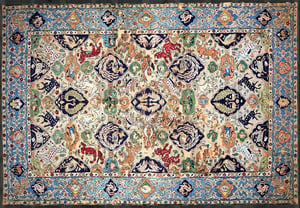12th–14th centuries is the first Islamic golden age, mostly from Syria and Iraq. Influence from Byzantine visual vocabulary (blue and gold coloring, angelic and victorious motifs, symbology of drapery) combined with Mongoloid facial types in 12th-century book frontispieces.
During their time, the center of culture, politics and art production shifted from Damascus and Baghdad to Merv, Nishapur, Rayy, and Isfahan, all in Iran. Popular patronage expanded because of a growing economy and new urban wealth. Inscriptions in architecture tended to focus more on the patrons of the piece. For example, sultans, viziers or lower ranking officials would receive often mention in inscriptions on mosques. Meanwhile, growth in mass market production and sale of art made it more commonplace and accessible to merchants and professionals. Because of increased production, many relics have survived from the Seljuk era and can be easily dated.
In Iran and the north of India, rchitecture was cultivated, while potters developed quite individual styles: kaleidoscopic ornament on a yellow ground; or marbled decorations created by allowing colored glazes to run; or painting with multiple layers of slip under the glaze.
Innovations in ceramics from this period include the production of minai ware and the manufacture of vessels, not out of clay, but out of a silicon paste, while metalworkers began to encrust bronze with precious metals. Across the Seljuk era, from Iran to Iraq, a unification of book painting can be seen. These paintings have animalistic figures that convey strong symbolic meaning of fidelity, treachery, and courage.
Museum of Islamic Art possesses a wide collection of Islamic antiques, alongside a wide range of artifacts from all over the world. As well as being objects of great age and beauty, the ceramics in the museum were also meant to be used. The collection includes:
From humble kitchen wares to elaborate tile panels, ceramics were a vital part of everyday life in the Islamic world. They exemplify the external influences and internal creativity that inspired this flourishing of ceramic design over 12 centuries.
Museum of Islamic Art, Doha
The Museum of Islamic Art (Arabic: متحف الفن الإسلامي,) is a museum located on one end of the seven kilometers long Corniche in the Qatari capital, Doha. As with the architect I. M. Pei’s requirement, the museum is built on an island off an artificial projecting peninsula near the traditional dhow (wooden Qatari boat) harbor. A purpose-built park surrounds the edifice on the Eastern and Southern facades while 2 bridges connect the Southern front facade of the property with the main peninsula that holds the park. The Western and Northern facades are marked by the harbor showcasing the Qatari seafaring past.
The Museum of Islamic Art (MIA) represents Islamic art from three continents over 1,400 years. Its collection includes metal work, ceramics, jewelry, wood work, textiles and glass obtained from three continents and dating from the 7th to the 19th century.
Qatar’s ambition to become the most important cultural destination of the Gulf’s area was made concrete in 2008 with the opening of the MIA, the Museum of Islamic Art. It was designed by I.M. Pei, the Chinese-American architect that notably built the glass pyramid for the Louvre in Paris. It is considered to be one of the world’s great museums.
The art scene in Qatar witnessed substantial development in the mid- and late 1950s. Initially, arts were overseen by the Ministry of Education, with art exhibitions being hosted in its facilities. In 1972, the government started providing increased funding to aid the development of arts within the country. The father of modern artists in Qatar is Jassim Zaini (1943-2012) whose work explored diversity in techniques and documented the changing society from traditional local life to a global style. The Qatari Fine Arts Society was established in 1980 with the objective of promoting the works of Qatari artists.In 1998, the National Council for Culture, Arts and Heritage was established. Qatar Museums was established in the early 2000s to build and connect all museums and collections in Qatar. Two major museums lead the institution: the Museum of Islamic Art opened in 2008, and the Mathaf: Arab Museum of Modern Art, opened in Education City Qatar Foundation in 2010.










